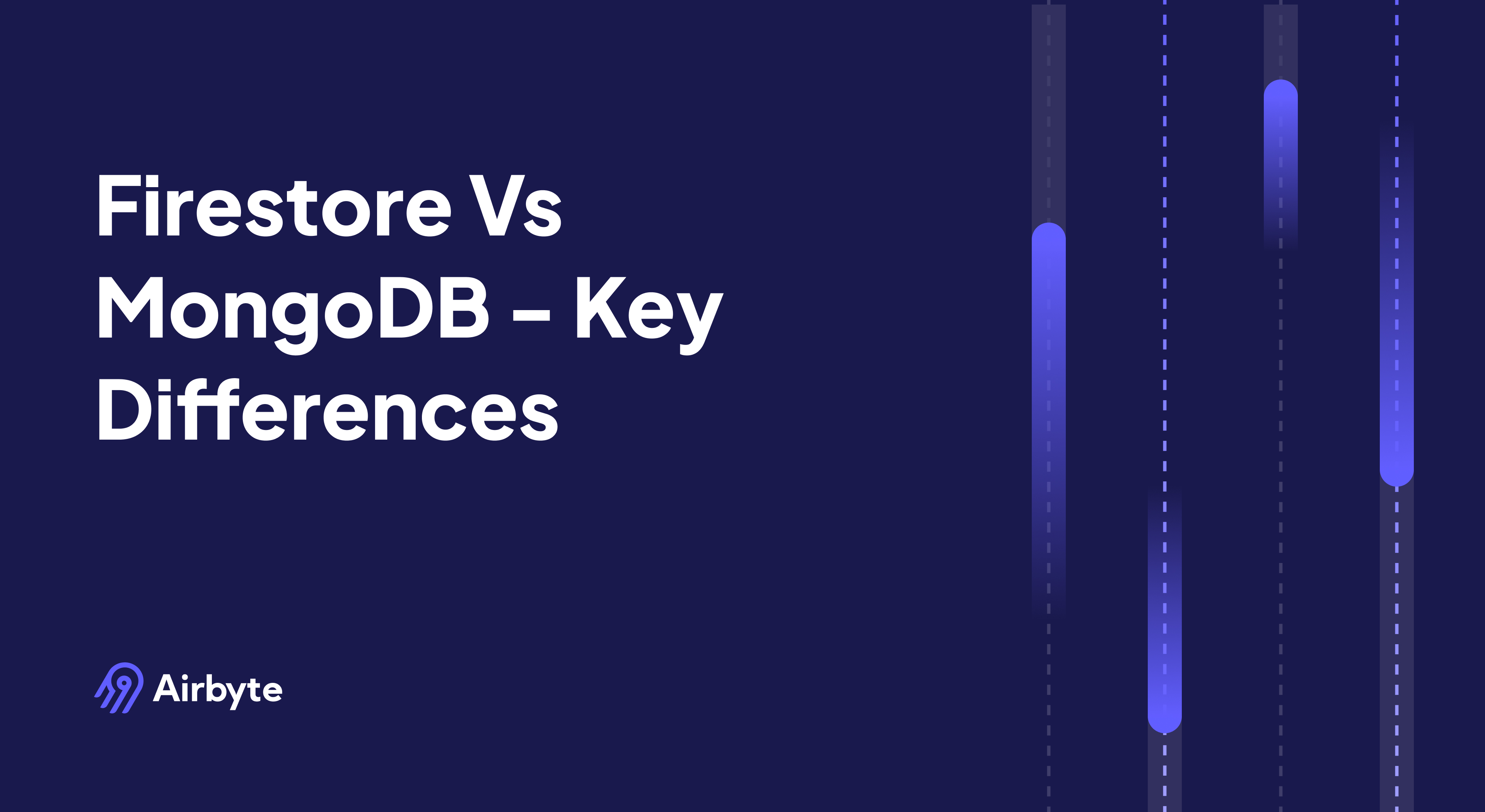Firestore Vs MongoDB - Key Differences
Summarize this article with:
✨ AI Generated Summary
Firestore and MongoDB are popular NoSQL databases with distinct strengths:
- Firestore offers serverless architecture, real-time synchronization, offline support, and tight integration with Google Cloud services, ideal for real-time web and mobile apps.
- MongoDB provides flexible schema design with BSON, powerful querying, sharding for horizontal scaling, robust security features, and broad ecosystem integration across cloud providers.
- Firestore excels in automatic scaling and low-latency real-time updates, while MongoDB supports advanced querying, manual real-time updates via Change Streams, and comprehensive backup solutions.
- Pricing models for both include free tiers and pay-as-you-go options, with MongoDB offering more flexible deployment choices.
- Data integration between Firestore and MongoDB can be streamlined using Airbyte, enabling efficient data syncing and transformation.
Organizations are constantly on the lookout for efficient ways to manage their growing volumes of unstructured and semi-structured data. NoSQL databases have a dynamic storage model that accommodates unstructured data in the form of documents, key-value pairs, wide columns, or graph representations. These databases make it easy to identify the complex relationships among the datasets.
Firestore and MongoDB are two popular NoSQL databases. They support nested structures that help you represent complex data relationships efficiently. While Firestore, used by 4.5% of developers, is optimized for real-time data synchronization in web applications, MongoDB is renowned for its powerful querying capabilities.
This article will list out the key distinctions between Firestore vs MongoDB and help you make the right choice based on your specific needs.
Understanding Firestore

Firestore is a NoSQL database with a document-oriented data model. It involves storing data in the form of documents instead of tables and rows. Firestore allows you to sync this data in online and offline sync modes, making it an ideal choice for building and deploying real-time applications.
Key Features and Functionalities
- Serverless: Firestore is fully managed and serverless; there is no need for manual partitioning or maintenance. It allows you to scale resources as per your requirements without any downtime.
- Expressive Querying: Querying data in Cloud Firestore is expressive. You can create queries to retrieve a single document or all documents within a collection based on certain parameters. These queries can be simple or compound, and you can perform operations like sorting or filtering data with them.
- Offline Support: Firestore caches data that your app uses actively. This allows you to write, read, listen to, or query data even when the device is offline. When your device is back online, Firestore synchronizes all the changes back to the database.
- Multi-Region Support: Multi-region support ensures that your data is highly available, reliable, and quickly accessible. Firestore supports multi-region data replication, copying your data across various regions and minimizing the risk of data loss.
Understanding MongoDB

MongoDB is an open-source NoSQL database that simplifies data management through a document-oriented model. The documents are data units formatted as Binary JSON (BSON) supporting different data types, including arrays, numbers, objects, and even binary data like images or files. It enables you to manage diverse datasets within a single environment without requiring predefined schemas.
Key Features and Functionalities
- Sharding: MongoDB uses sharding to split data across multiple servers or shards, each serving as a mini database. This promotes horizontal scaling and allows you to efficiently handle data traffic and performance.
- Indexing: MongoDB indexing optimizes query performance by limiting the number of documents it has to scan within a collection to generate the query results. This quickens the process of identifying and matching the data with the query statement.
- Replication: In MongoDB, a primary server node accepts all the write operations and applies them across secondary servers, replicating the data. If the primary server fails, the secondary server can take over as the new primary node, preventing data loss.
- Authentication: MongoDB provides various authentication mechanisms, such as the Salted Challenge Response Authentication Mechanism (SCRAM). It requires you to provide a username, password, and database name, ensuring only authenticated users can access the data.
Core Differences: Firestore Vs MongoDB
The main difference between Firestore and MongoDB is that Firestore is a NoSQL database within Firebase, optimized for real-time data synchronization and scalability, while MongoDB is a flexible, document-oriented NoSQL database suitable for diverse use cases and self-managed deployments.
Firestore Vs MongoDB: Data Structure
Firestore is a document-oriented database that enables you to store data within documents, which can be organized into collections. The document is the unit of storage consisting of fields in key-value pairs. Each field represents a piece of data like name or age and helps you map to the corresponding values. For instance, the field labeled ‘age’ might be mapped to a value ‘14’.
In contrast, MongoDB facilitates data storage in BSON (Binary JSON) format. BSON is an extended version of JSON, including additional data types such as dates and bindata. These additional data types enhance MongoDB’s flexibility to handle complex data structures.
Firestore Vs MongoDB: Horizontal Scaling
Cloud Firestore can automatically scale your data as needed. It implements horizontal scaling by distributing your data across multiple servers. This approach helps when the number of users increases and when managing heavy data loads effectively.
On the other hand, horizontal scaling within a MongoDB database is supported by features like sharding and replication. These features allow you to distribute large datasets into smaller chunks and replicate data across multiple servers for efficient scaling, data management, and backup.
Firestore Vs MongoDB: Querying Capabilities
Firestore provides you with varied querying functionalities; you can specify the document or collection of documents you want to retrieve. It supports two types of queries, simple and compound, as well as collection group queries to retrieve a document from a group of collections. You can use these queries alongside functions like get() and addSnapshotListener().
However, MongoDB offers several options for querying and retrieving data. Field queries can help you search for documents where a specific field matches a value. Additionally, Geo queries can be helpful in searching documents based on geographical data. MongoDB also allows you to create ad hoc queries, which are used to filter data based on conditions, like identifying users who have more than three purchases.
Firestore Vs MongoDB: Security and Authentication
Firestore offers two different methods for robust access management and authentication. For mobile and client libraries, you can use Firebase Authentication and Firestore Security Rules. These security rules provide access control and data validation; every request from the web/mobile client library is evaluated against the rules before performing read or write operations. For the server-client interactions, you can use IAM in Firestore to manage access to data.
MongoDB also offers various built-in security features to prevent and detect unauthorized data access. It facilitates granular auditing that monitors actions, including reading, writing, creating, and updating. You can also implement Role Based Access Control (RBAC) and encryption, protecting your data in transit and at rest.
Firestore Vs MongoDB: Ecosystem Integration Capabilities
Firestore is tightly integrated with Google Cloud Services, such as Cloud Functions, Firebase Authentication, and Firebase Hosting. It supports Firebase SDKs for Android, iOS, and web, which support mobile and web applications. Firestore can also work with third-party tools like Google Analytics and Firebase ML Kit.
On the other hand, MongoDB allows you to integrate with different services and tools across various ecosystems, including AWS, Azure, and Google Cloud. It also supports drivers for many programming languages like Python, Node.js, Java, and more. MongoDB’s cloud-based solution, MongoDB Atlas, can be integrated with third-party tools like Tableau for analysis.
Firestore Vs MongoDB: Pricing
Firestore pricing plan offers free tier and pay-as-you-go pricing models. The free-tier model allows you to start with your default database at no initial cost. In this model, you get 1 GB of stored data, 50,000 document reads, and 20,000 document writes per day. For the pay-as-you-go model, you only pay for the resources you use without generating any upfront costs.
Comparatively, the MongoDB pricing plan offers greater flexibility. It includes a free tier that's perfect for learning and exploration, as well as a pay-as-you-go model with dedicated pricing or a serverless option where charges are based on individual operations.
Performance and Benchmark Comparison: MongoDB vs Firestore
You might want to consider the following factors while evaluating the performance of Firestore and MongoDB:
Latency and Throughput
Firestore has low latency with a typical response time of no more than 30ms. In terms of throughput, Firestore delivers highly scalable read and write operations even during heavy load. This results in quick data retrieval and updates.
The latency in MongoDB is influenced by several factors including network congestion and bandwidth limitations. You can check the latency statistics using the db.collection.latencyStats() method. As for throughput, MongoDB can handle high volumes of read and write operations, supported by horizontal scaling through sharding.
Automated Backups
Cloud Firestore provides you with a scheduled backup feature that allows you to regularly backup your data. However, you have to manually set up and implement this feature, specifying where your backups should be stored.
On the other hand, MongoDB supports backups through MongoDB Cloud Manager, which is a monitoring and automation service. It also allows you to restore and back up replica sets and shard clusters. You can also use MongoDB Atlas, which has snapshot functionality that enables you to take immediate and recurring snapshots for your deployment.
Realtime Time Updates
In Firestore, you can use the onSnapshot() method for real-time updates. When you set up a listener with this method, you can retrieve the current version of your document. Anytime the document changes, the listener updates it automatically, providing real-time synchronization.
However, in MongoDB, you can get updates with manual methods like using Change Streams, which may not be as fast as Firestore’s real-time sync.
Offline Support
Firestore has built-in offline support. The data within your database is cached locally and syncs automatically when the application is back online. This offline support improves performance and data management.
Compared to this, MongoDB does not natively provide offline support, but you can setup MongoDB locally and then test it without an internet connection. You can also use MongoDB Realm, a part of the MongoDB ecosystem, for offline-first capabilities.
Connect Your Data Sources with MongoDB and Firestore Using Airbyte
Connecting MongoDB and Firestore can enhance data management and improve data consistency.
Airbyte, a data integration tool, simplifies the process of data movement between MongoDB and Firestore. Using its intuitive interface and extensive connector library, you can build a data pipeline and load data from MongoDB to Firestore within minutes. Alternatively, if you want to move data from any other source into MongoDB or Firestore, you can choose from Airbyte’s 400+ connectors to accomplish it.

Here’s how Airbyte’s robust features streamline Firestore and MongoDB data integration:
- Change Data Capture: With Change Data Capture, you can identify incremental changes within your source system and replicate them in your destination system. This ensures the data is consistent and up-to-date.
- Custom dbt Transformations: Using Airbyte’s dbt cloud integration, you can create and run transformations immediately after syncing data between MongoDB and Firestore. These transformations include cleaning and enriching the raw data into a format suitable for analysis.
- Connector Development Kit (CDK): Airbyte offers a Connector Development Kit that allows you to create custom connectors specifically for your needs.
- Record Change History: This feature is particularly useful when you want to record all the changes made to your data. For instance, the record change history will alert you of any modification made while transferring data from MongoDB to Firestore.
Conclusion
Firestore and MongoDB are two robust NoSQL databases, each with unique capabilities that cater to different use cases.
Firestore is an efficient solution for its serverless architecture, seamless integration with Google Cloud, and real-time synchronization. On the other hand, MongoDB offers powerful querying capabilities along with the flexibility of managing diverse datasets.
The choice between Firestore and MongoDB comes down to the unique requirements of your application and its feasibility.

